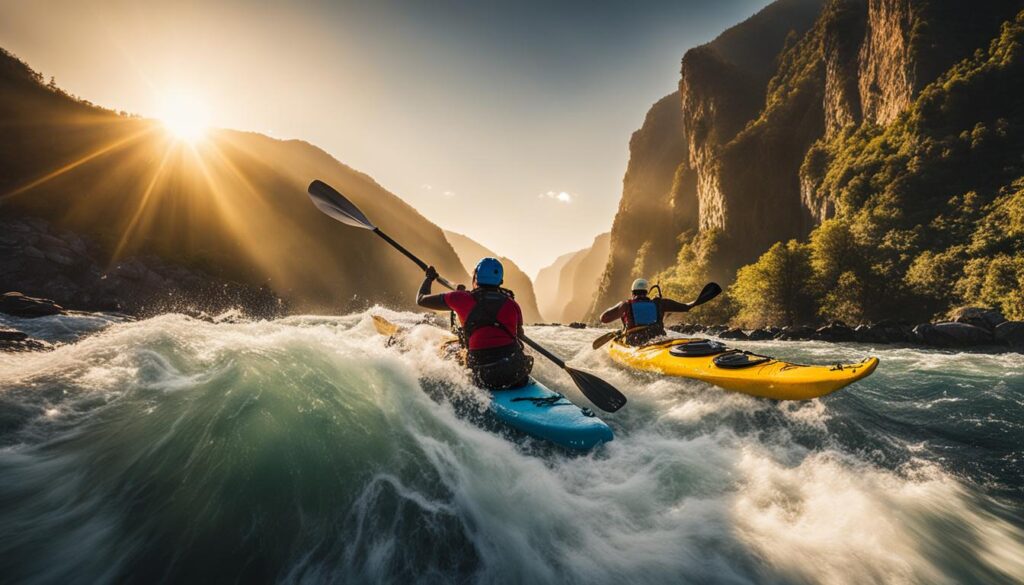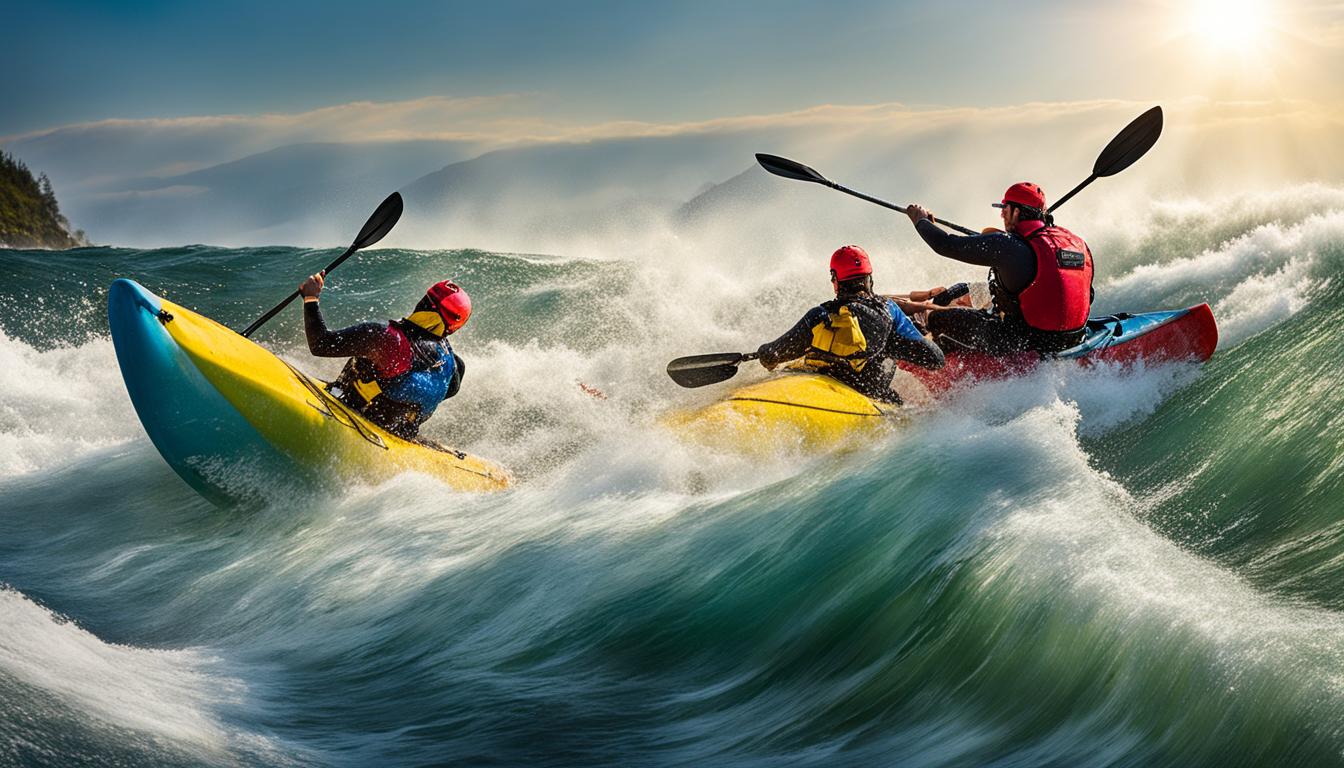Kayaking is an exhilarating sport that offers adventure, tranquility, and physical workout. To unlock your full potential and enhance your kayaking experience, advanced T-rescue skills are essential. These skills allow you to handle challenging conditions, coordinate T-rescues with partners, and achieve efficiency in your rescue techniques. By learning different T-rescue variations for various waters, you can become a more skilled and confident kayaker.
Key Takeaways:
- Advanced T-rescue skills are crucial for handling challenging conditions in kayaking.
- Coordinating T-rescues with partners enhances safety and efficiency in rescue situations.
- Learning different T-rescue variations for various waters improves your skills as a kayaker.
- By honing advanced T-rescue techniques, you can elevate your kayaking abilities to new heights.
- Continual practice and perfecting the T-rescue flip ensure preparedness for emergency situations.
Understanding the Basics of Kayaking
Before you can embark on mastering advanced T-rescue techniques, it’s essential to have a solid foundation in the basics of kayaking. Familiarizing yourself with the different types of kayaks is key to choosing the right vessel for specific water conditions. Whether it’s a recreational kayak for calm lakes or a whitewater kayak for thrilling rapids, understanding the characteristics and capabilities of each type will ensure a safe and enjoyable kayaking experience.
In addition to knowing your kayak, it’s crucial to be well-versed in equipment knowledge. You should be familiar with the various pieces of gear, such as personal flotation devices (PFDs), paddles, and spray skirts, and understand how to use them effectively. This knowledge will not only enhance your safety on the water but also contribute to overall equipment maintenance and longevity.
Water awareness is another fundamental aspect of kayaking that should not be overlooked. Being aware of your surroundings and potential hazards can prevent accidents and ensure a smooth paddling experience. Understanding the flow of the current, recognizing submerged obstacles, and staying informed about weather conditions are all essential for a safe and enjoyable time on the water.
Finally, mastering basic paddling techniques is essential to propel yourself efficiently through the water. The forward stroke, backward stroke, and sweep stroke are foundational techniques that allow you to steer, maneuver, and maintain control of your kayak. By practicing and refining these techniques, you’ll build the necessary skills to navigate various water conditions with confidence.

Kayak Types:
| Kayak Type | Water Conditions | Key Features |
|---|---|---|
| Recreational Kayaks | Calm lakes and slow-moving rivers | Stability, comfort, and easy maneuverability |
| Sea Kayaks | Coastal areas, open water, and ocean paddling | Long, narrow design for speed and efficiency |
| Touring Kayaks | Inland lakes, multi-day trips | Storage space, stability, and tracking ability |
| Whitewater Kayaks | Fast-moving rivers, rapids | Agility, maneuverability, and impact resistance |
By understanding the basics of kayaking, including the different types of kayaks, equipment knowledge, water awareness, and basic paddling techniques, you’ll establish a strong foundation for advancing your skills. Building upon this knowledge, you’ll be ready to explore more challenging waters and acquire the advanced T-rescue techniques necessary to take your kayaking abilities to the next level.
Importance of Physical Conditioning for Kayaking
Kayaking requires more than just technical skills and knowledge of the water. It demands physical fitness and strength to maneuver through challenging conditions and paddle effectively. By focusing on cardiovascular fitness, upper body strength, core strength, and flexibility, you can significantly improve your kayaking performance and minimize the risk of injuries.
To keep up with the demands of kayaking, prioritize cardiovascular fitness. Engage in activities such as running, cycling, and swimming to strengthen your heart and lungs. Not only will this improve your overall endurance, but it will also enhance your ability to handle long paddling sessions and challenging water conditions.
Additionally, developing upper body strength is crucial for generating powerful paddle strokes. Work on exercises that target your arms, shoulders, and back muscles. This will not only improve your paddling technique but also help you paddle with more efficiency and control.
Core strength is another essential component of physical conditioning for kayakers. A strong core provides stability and balance, allowing you to maneuver your kayak more effectively. Incorporate exercises like planks, Russian twists, and sit-ups into your routine to strengthen your core muscles. This will enhance your overall paddling performance and reduce the risk of back injuries.
| Physical Conditioning | Key Benefits |
|---|---|
| Cardiovascular Fitness | Improves endurance and stamina for long paddling sessions. |
| Upper Body Strength | Enhances paddle strokes and overall control. |
| Core Strength | Provides stability and balance for effective maneuvering. |
| Flexibility | Increases range of motion and reduces the risk of strain or injury. |
Lastly, don’t underestimate the importance of flexibility. Stretching regularly will improve your range of motion, allowing for smoother and more efficient paddle strokes. Incorporate exercises like yoga or Pilates into your routine to enhance flexibility and prevent muscle tightness or imbalances.
Remember, investing time and effort into your physical conditioning will not only enhance your kayaking abilities but also ensure a safer and more enjoyable experience on the water. By improving your cardiovascular fitness, upper body strength, core strength, and flexibility, you’ll be well-equipped to tackle any kayaking adventure that comes your way.

Optimal Kayaking Posture
When it comes to kayaking, maintaining the correct posture is essential for both efficiency and injury prevention. The way you position your body affects your paddling technique and overall comfort on the water. Here are some key aspects of optimal kayaking posture that you should keep in mind:
Sitting Position
Start by sitting with a straight back and avoiding slouching. This will help you maintain better balance and control in your kayak. Center yourself in the seat to distribute your weight evenly and ensure stability throughout your paddling strokes.
Foot Position
Your feet play a crucial role in providing stability and control. Position them firmly against the footpegs, making sure they’re snug but not too tight. This will allow you to transfer power from your lower body to your paddling strokes and maintain balance in various water conditions.
Back Position
Lean slightly forward from your hips to match the angle of your kayak. This forward-leaning posture helps you engage your core muscles and achieve a more efficient paddling motion. It also prevents strain on your lower back and promotes better torso rotation during each stroke.
Arm Position
Keep your elbows at a comfortable angle, slightly bent, and close to your body. Avoid locking your elbows, as this can lead to muscle fatigue and strain. By maintaining a relaxed arm position, you’ll be able to execute smooth and powerful paddle strokes without unnecessary tension.
Torso Rotation
One of the most critical elements of kayaking posture is proper torso rotation. Engage your core muscles and focus on twisting your torso with each paddle stroke. This rotation not only allows you to generate more power but also reduces strain on your arms and shoulders. The combination of a strong core and effective torso rotation will greatly enhance your paddling efficiency.
By practicing and maintaining optimal kayaking posture, you’ll improve your paddling technique, reduce the risk of injuries, and enjoy a more comfortable and efficient kayaking experience.
Conclusion
By honing your advanced T-rescue skills in kayaking, you can elevate your abilities to new heights. These skills are crucial for handling challenging conditions and coordinating T-rescues with your partners, ensuring a safer and more efficient rescue experience.
Continual practice and perfecting the T-rescue flip will equip you with the necessary tools to confidently navigate various waters. Whether you encounter rough currents or unexpected emergencies, you can approach each situation with peace of mind.
Remember, advanced T-rescue skills are not only about mastering techniques but also about maintaining a calm and composed mindset under pressure. Being prepared and having confidence in your abilities will allow you to fully enjoy the thrill of kayaking while ensuring your safety and the safety of others around you.
FAQ
What are advanced T-rescue skills?
Advanced T-rescue skills are techniques that allow kayakers to handle challenging conditions, coordinate T-rescues with partners, and achieve efficiency in their rescue techniques.
Why is it important to have a solid grasp of the basics of kayaking?
Understanding the basics of kayaking, including the different types of kayaks, equipment knowledge, water awareness, and basic paddling techniques, is crucial for a safe and enjoyable kayaking experience.
How does physical conditioning contribute to kayaking performance?
Physical conditioning, including cardiovascular fitness, upper body strength, core strength, and flexibility, plays a vital role in enhancing kayaking performance and reducing the risk of injuries.
What is the optimal posture for kayaking?
The optimal posture for kayaking includes sitting with a straight back, centered in the seat, feet against the footpegs for control and stability, leaning slightly forward from the hips, keeping the elbows at a comfortable angle, and engaging the core for torso rotation.
Why are advanced T-rescue skills essential in kayaking?
Advanced T-rescue skills are essential in kayaking as they enable kayakers to handle challenging conditions, coordinate T-rescues with partners, and ensure a safer and more efficient rescue experience.





